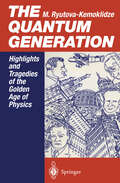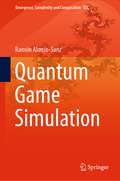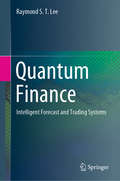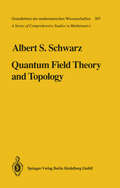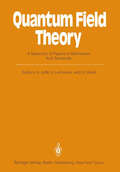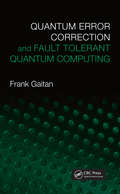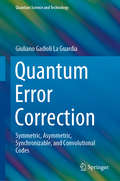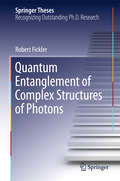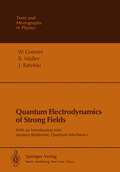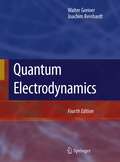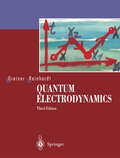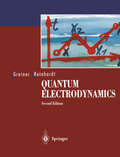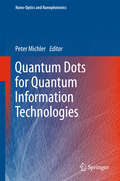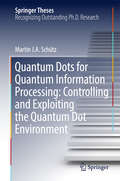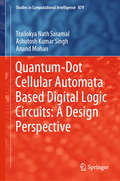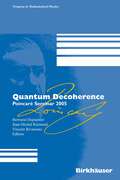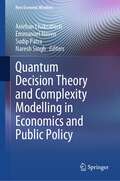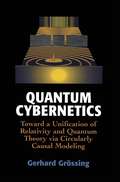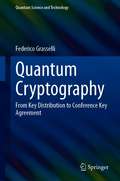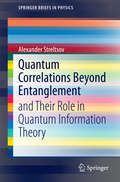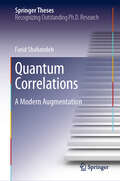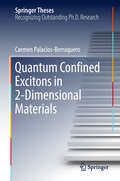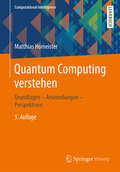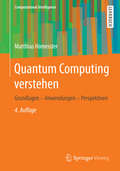- Table View
- List View
The Quantum Generation: Highlights and Tragedies of the Golden Age of Physics
by Margarita Ryutova-KemoklidzeQuantum mechanics dates its anniversaries from 1925, the year when its first versions, matrix and wave mechanics, were born. The quan tum itself had by that time reached the age of 25, having first seen the light of day on the eve of the nativity of the 20th century itself. Either shunned or completely unnoticed, the quantum seemed for a long time to be an illegitimate child. Even Max Planck himself, its own father, could not bring himself to accept his monstrous child until he was forced to do so -that is, until it became clear that the problems which were arising in physics could not be solved without the quantum. At first the quantum "like a greasy stain, soaked through all the different branches of physics" and then, like an explosion, came the creation of quantum mechanics. The overwhelming majority of those who first created quantum mechanics were just about of an age with the quantum itself. These were very young people, born as the new century was born, give or take a year or so. Hence the phrase was coined - "the quantum generation". At that time there was quantum everything - towns, steps, park benches, lodging houses and so, natu rally, the quantum generation.
Quantum Game Simulation (Emergence, Complexity and Computation #36)
by Ramon Alonso-SanzThis book addresses two disciplines that have traditionally occupied completely different realms: quantum information and computation, and game theory. Helping readers connect these fields, it appeals to a wide audience, including computer scientists, engineers, mathematicians, physicists, biologists or economists. The book is richly illustrated and basic concepts are accessible to readers with basic training in science. As such it is useful for undergraduate students as well as established academicians and researchers. Further, the didactic and tutorial-like style makes it ideal supplementary reading for courses on quantum information and computation, game theory, cellular automata and simulation.
Quantum Finance: Intelligent Forecast and Trading Systems
by Raymond S. LeeWith the exponential growth of program trading in the global financial industry, quantum finance and its underlying technologies have become one of the hottest topics in the fintech community. Numerous financial institutions and fund houses around the world require computer professionals with a basic understanding of quantum finance to develop intelligent financial systems. This book presents a selection of the author’s past 15 years’ R&D work and practical implementation of the Quantum Finance Forecast System – which integrates quantum field theory and related AI technologies to design and develop intelligent global financial forecast and quantum trading systems. The book consists of two parts: Part I discusses the basic concepts and theories of quantum finance and related AI technologies, including quantum field theory, quantum price fields, quantum price level modelling and quantum entanglement to predict major financial events. Part II then examines the current, ongoing R&D projects on the application of quantum finance technologies in intelligent real-time financial prediction and quantum trading systems. This book is both a textbook for undergraduate & masters level quantum finance, AI and fintech courses and a valuable resource for researchers and data scientists working in the field of quantum finance and intelligent financial systems. It is also of interest to professional traders/ quants & independent investors who would like to grasp the basic concepts and theory of quantum finance, and more importantly how to adopt this fascinating technology to implement intelligent financial forecast and quantum trading systems. For system implementation, the interactive quantum finance programming labs listed on the Quantum Finance Forecast Centre official site (QFFC.org) enable readers to learn how to use quantum finance technologies presented in the book.
Quantum Field Theory and Topology (Grundlehren der mathematischen Wissenschaften #307)
by Albert S. SchwarzIn recent years topology has firmly established itself as an important part of the physicist's mathematical arsenal. It has many applications, first of all in quantum field theory, but increasingly also in other areas of physics. The main focus of this book is on the results of quantum field theory that are obtained by topological methods. Some aspects of the theory of condensed matter are also discussed. Part I is an introduction to quantum field theory: it discusses the basic Lagrangians used in the theory of elementary particles. Part II is devoted to the applications of topology to quantum field theory. Part III covers the necessary mathematical background in summary form. The book is aimed at physicists interested in applications of topology to physics and at mathematicians wishing to familiarize themselves with quantum field theory and the mathematical methods used in this field. It is accessible to graduate students in physics and mathematics.
Quantum Field Theory: A Selection of Papers in Memoriam Kurt Symanzik
by Arthur Jaffe Harry Lehmann Gerhard MackKurt Symanzik was certainly one of the most outstanding theoretical physicists of our time. For thirty years, until his untimely death in 1983, he helped to shape the present form of quantum field theory and its application to elementary particle physics. In memoriam of Kurt" Symanzik leading scientists present their most recent results, giving, at the same time, an overview of the state of the art. This collection was originally published in Vol. 97, 1/2 (1985) of Communications in Mathematical Physics. They range over various inter related topics of interest to Kurt Symanzik. We hope that making this collection available in an accessible and inexpensive way will benefit the physics community. The Publisher Contents To the Memory of Kurt Symanzik 1 By A. Jaffe, H. Lehmann, and G. Mack Monte Carlo Simulations for Quantum Field Theories Involving Fermions. By M. Karowski, R. Schrader, and H. J. Thun (With 8 Figures) . . . . . . . . . . . . . . . . . . . 5 SU(2) Lattice Gauge Theory: Standard Action Versus Symanzik's Tree-Improved Action. By B. Berg, A. Billoire, S. Meyer, and C. Panagiotakopoulos (With 13 Figures). . . . . . . . . . 31 . On-shell Improved Lattice Gauge Theories By M. Luscher and P. Weisz (With 3 Figures) . . . . . 59 On the Modular Structure of Local Algebras of Observables By K. Fredenhagen . . . . . . . . . . . . . . . . . 79 . . . The Intersection of Brownian Paths as a Case Study of a Renormalization Group Method for Quantum Field Theory By M. Aizenman (With 3 Figures). . . . . . . . . . . . 91 Intersection Properties of Simple Random Walks: A Renormalization Group Approach. By G. Felder and J. Frohlich. . . . . . . 111 .
Quantum Error Correction and Fault Tolerant Quantum Computing
by Frank GaitanIt was once widely believed that quantum computation would never become a reality. However, the discovery of quantum error correction and the proof of the accuracy threshold theorem nearly ten years ago gave rise to extensive development and research aimed at creating a working, scalable quantum computer. Over a decade has passed since this monumental accomplishment yet no book-length pedagogical presentation of this important theory exists. Quantum Error Correction and Fault Tolerant Quantum Computing offers the first full-length exposition on the realization of a theory once thought impossible. It provides in-depth coverage on the most important class of codes discovered to date—quantum stabilizer codes. It brings together the central themes of quantum error correction and fault-tolerant procedures to prove the accuracy threshold theorem for a particular noise error model. The author also includes a derivation of well-known bounds on the parameters of quantum error correcting code. Packed with over 40 real-world problems, 35 field exercises, and 17 worked-out examples, this book is the essential resource for any researcher interested in entering the quantum field as well as for those who want to understand how the unexpected realization of quantum computing is possible.
Quantum Error Correction: Symmetric, Asymmetric, Synchronizable, and Convolutional Codes (Quantum Science and Technology)
by Giuliano Gadioli La GuardiaThis text presents an algebraic approach to the construction of several important families of quantum codes derived from classical codes by applying the well-known Calderbank-Shor-Steane (CSS), Hermitian, and Steane enlargement constructions to certain classes of classical codes. In addition, the book presents families of asymmetric quantum codes with good parameters and provides a detailed description of the procedures adopted to construct families of asymmetric quantum convolutional codes.Featuring accessible language and clear explanations, the book is suitable for use in advanced undergraduate and graduate courses as well as for self-guided study and reference. It provides an expert introduction to algebraic techniques of code construction and, because all of the constructions are performed algebraically, it enables the reader to construct families of codes, rather than only codes with specific parameters. The text offers an abundance of worked examples, exercises, and open-ended problems to motivate the reader to further investigate this rich area of inquiry. End-of-chapter summaries and a glossary of key terms allow for easy review and reference.
Quantum Entanglement of Complex Structures of Photons (Springer Theses)
by Robert FicklerThis thesis casts new light on quantum entanglement of photons with complex spatial patterns due to direct coincidence imaging. It demonstrates novel methods to generate, investigate, and verify entanglement of complex spatial structures. Quantum theory is one of the most successful and astonishing physical theories. It made possible various technical devices like lasers or mobile phones and, at the same time, it completely changed our understanding of the world. Interestingly, such counterintuitive features like entanglement are an important building block for future quantum technologies. In photonic experiments, the transverse spatial degree of freedom offers great potential to explore fascinating phenomena of single photons and quantum entanglement. It was possible to verify the entanglement of two photons with very high quanta of orbital angular momentum, a property of photons connected to their spatial structure and theoretically unbounded. In addition, modern imaging technology was used to visualize the effect of entanglement even in real-time and to show a surprising property: photons with complex spatial patterns can be both entangled and not entangled in polarization depending on their transverse spatial position.
Quantum Electrodynamics of Strong Fields: With an Introduction into Modern Relativistic Quantum Mechanics (Theoretical and Mathematical Physics)
by Walter Greiner B. Müller J. RafelskiThe fundamental goal of physics is an understanding of the forces of nature in their simplest and most general terms. Yet there is much more involved than just a basic set of equations which eventually has to be solved when applied to specific problems. We have learned in recent years that the structure of the ground state of field theories (with which we are generally concerned) plays an equally funda mental role as the equations of motion themselves. Heisenberg was probably the first to recognize that the ground state, the vacuum, could acquire certain prop erties (quantum numbers) when he devised a theory of ferromagnetism. Since then, many more such examples are known in solid state physics, e. g. supercon ductivity, superfluidity, in fact all problems concerned with phase transitions of many-body systems, which are often summarized under the name synergetics. Inspired by the experimental observation that also fundamental symmetries, such as parity or chiral symmetry, may be violated in nature, it has become wide ly accepted that the same field theory may be based on different vacua. Practical ly all these different field phases have the status of more or less hypothetical models, not (yet) directly accessible to experiments. There is one magnificent ex ception and this is the change of the ground state (vacuum) of the electron-posi tron field in superstrong electric fields.
Quantum Electrodynamics
by Walter Greiner Joachim ReinhardtWe are pleased by the positive resonance of our book which now necessitates a fourth edition. We have used this opportunity to implement corrections of misprints and amendments at several places, and to extend and improve the discussion of many of the exercises and examples. We hope that our presentation of the method of equivalent photons (Example 3. 17), the form factor of the electron (Example 5. 7), the infrared catastrophe (Example 5. 8) and the energy shift of atomic levels (Example 5. 9)arenow even better to understand. The new Exercise 5. 10 shows in detail how to arrive at the non-relativistic limit for the calculation of form factors. Moreover, we have brought up-to-date the Biographical Notes about physicists who have contributed to the dev- opment of quantum electrodynamics, and references to experimental tests of the t- ory. For example, there has been recent progress in the determination of the electric and magnetic form factors of the proton (discussed in Exercise 3. 5 on the Rosenbluth formula) and the Lamb shift of high-Z atoms (discussed in Example 5. 9 on the energy shift of atomic levels), while the experimental veri cation of the birefringence of the QED vacuum in a strong magnetic eld (Example 7. 8) remains unsettled and is a topic of active ongoing research.
Quantum Electrodynamics
by Walter Greiner Joachim ReinhardtSince the need for a third edition of this book has arisen, we have endeavoured to improve and extend it in several ways. At many places small changes were made, misprints have been corrected, and references have been added. In Chap. 5 new theoretical and experimental results on the Lamb shift in heavy atoms and on the anomalous magnetic moment of the muon are reported. We have also added a number of new topics in Chaps. 3, 5, and 7 in the form of examples and exercises. Example 3. 19 contains a detailed treatment of electron-positron pair production in the collision of a high-energy photon with a laser beam. This is supplemented by Exercise 3. 20 where a closed solution of the Dirac equation in the field of a plane wave is derived. Furthermore, Example 5. 4 on the running coupling constant in QED and Example 7. 6 on the supercritial point charge prob lem have been added. Finally, Example 7. 8 treats the birefringence of the QED vacuum in a strong magnetic field. We thank all colleagues and readers who have informed us about misprints in the book and are grateful to the team at Springer-Verlag for expertly handling the preparation of this new edition. Frankfurt am Main, Walter Greiner August 2002 Joachim Reinhardt Preface to the Second Edition The need for a second edition of our text on Quantum Electrodynamics has given us the opportunity to implement some corrections and amendments.
Quantum Electrodynamics
by Walter Greiner Joachim ReinhardtThe need for a second edition of our text on Quantum Electrodynamics has given us the opportunity to implement some corrections and amendments. We have corrected a number of misprints and minor errors and have supplied additional explanatory remarks at various places. Furthermore some new material has been included on the magnetic moment of the muon (in Example 5. 6) and on the Lamb shift (in Example 5. 8). Finally, we have added the new Example 3. 17 which explains the equivalent photon method. We thank several colleagues for helpful comments and also are grateful to Dr. R. Mattiello who has supervised the preparation of the second edition of the book. Furthermore we acknowledge the agreeable collaboration with Dr. H. J. K6lsch and his team at Springer-Verlag, Heidelberg. Frankfurt am Main, Walter Greiner July 1994 Joachim Reinhardt Preface to the First Edition Theoretical physics has become a many-faceted science. For the young student it is difficult enough to cope with the overwhelming amount of new scientific material that has to be learned, let alone obtain an overview of the entire field, which ranges from mechanics through electrodynamics, quantum mechanics, field theory, nuclear and heavy-ion science, statistical mechanics, thermodynamics, and solid state theory to elementary-particle physics. And this knowledge should be acquired in just 8-10 semesters, during which, in addition, a Diploma or Master's thesis has to be worked on or examinations prepared for.
Quantum Dynamical Semigroups and Applications (Lecture Notes in Physics #717)
by Robert Alicki K. LendiReinvigorated by advances and insights the quantum theory of irreversible processes has recently attracted growing attention. This volume introduces the very basic concepts of semigroup dynamics of open quantum systems and reviews a variety of modern applications. Originally published as Volume 286 (1987) in Lecture in Physics, this volume has been newly typeset, revised and corrected and also expanded to include a review on recent developments.
Quantum Dots for Quantum Information Technologies (Nano-Optics and Nanophotonics)
by Peter MichlerThis book highlights the most recent developments in quantum dot spin physics and the generation of deterministic superior non-classical light states with quantum dots. In particular, it addresses single quantum dot spin manipulation, spin-photon entanglement and the generation of single-photon and entangled photon pair states with nearly ideal properties. The role of semiconductor microcavities, nanophotonic interfaces as well as quantum photonic integrated circuits is emphasized. The latest theoretical and experimental studies of phonon-dressed light matter interaction, single-dot lasing and resonance fluorescence in QD cavity systems are also provided. The book is written by the leading experts in the field.
Quantum Dots for Quantum Information Processing: Controlling and Exploiting the Quantum Dot Environment (Springer Theses)
by Martin J. SchützThis thesis offers a comprehensive introduction to surface acoustic waves in the quantum regime. It addresses two of the most significant technological challenges in developing a scalable quantum information processor based on spins in quantum dots: (i) decoherence of the electronic spin qubit due to the surrounding nuclear spin bath, and (ii) long-range spin-spin coupling between remote qubits. Electron spins confined in quantum dots (QDs) are among the leading contenders for implementing quantum information processing. To this end, the author pursues novel strategies that turn the unavoidable coupling to the solid-state environment (in particular, nuclear spins and phonons) into a valuable asset rather than a liability.
Quantum-Dot Cellular Automata Based Digital Logic Circuits: A Design Perspective (Studies in Computational Intelligence #879)
by Trailokya Nath Sasamal Ashutosh Kumar Singh Anand MohanThis book covers several futuristic computing technologies like quantum computing, quantum-dot cellular automata, DNA computing, and optical computing. In turn, it explains them using examples and tutorials on a CAD tool that can help beginners get a head start in QCA layout design. It discusses research on the design of circuits in quantum-dot cellular automata (QCA) with the objectives of obtaining low-complexity, robust designs for various arithmetic operations. The book also investigates the systematic reduction of majority logic in the realization of multi-bit adders, dividers, ALUs, and memory.
Quantum Decoherence: Poincaré Seminar 2005 (Progress in Mathematical Physics #48)
by Jean-Michel Raimond Vincent RivasseauThis volume is devoted to Quantum Decoherence with lectures from the Séminaire Poincaré, held in November 2005 at the Institute Henri Poincaré Paris. The goal of this seminar is to provide up-to-date information about general topics of great interest in physics. Both the theoretical and experimental results are covered, with some historical background. Particular care is devoted to the pedagogical nature of the presentation.
Quantum Decision Theory and Complexity Modelling in Economics and Public Policy (New Economic Windows)
by Anirban Chakraborti Emmanuel Haven Sudip Patra Naresh SinghThis book is an outcome of the interdisciplinary conference held at OP Jindal Global University (Quantum Decision-making and Complexity modeling, and their possible applications in social sciences- economics, finance and public policy). The volume builds upon the emerging fields of Econophysics, Complexity theory and Quantum like modelling in cognition and social sciences, and their plausible applications in economics and public policy. There can be deep linkages between the micro, meso and macro scales at which these paradigms operate. In this data-driven age, greater amounts of information, along with the facility to harvest, sort and process said information, have permitted an expansion of the capability to study a society’s various factors to a degree of detail and inclusiveness that has never before been available to researchers. As a result, an increasing number of throughlines is being discovered, revealing heretofore unknown connections between various disciplines and enhancing the study of such societal tropes as finance, language, shared behavior, and many others. As the reader will see, with clearer understanding of the interconnectedness of society’s assorted parts comes a clearer understanding of the society as a whole. We have received critical thoughts from noted experts in social and natural sciences to explore possible interconnections. The editors of this book earnestly hope that the critical reviews presented in this volume will stimulate further scholarly interest, but also interest among policy practitioners for the purpose of exploring possibilities for creating a new paradigm for comprehending pressing issues of deep uncertainty and emergence in social dynamics.
Quantum Cybernetics: Toward a Unification of Relativity and Quantum Theory via Circularly Causal Modeling
by Gerhard GrössingWritten for non-specialists, this book discusses the apparent conflict between relativity and quantum mechanics. The author proposes a resolution based on a causal interpretation introduced by Louis deBroglie and elaborated by David Bohm. He shows that a "medium" or "aether" may be introduced in a manner consistent with both relativity and quantum theory, and which allows the two theories to be unified via the identification of circularly causal processes at their core. While several crucial experiments are discussed in detail, the mathematics is kept simple, making the discussion accessible to a wide audience.
Quantum Cryptography: From Key Distribution to Conference Key Agreement (Quantum Science and Technology)
by Federico GrasselliRising concerns about the security of our data have made quantum cryptography a very active research field in recent years. Quantum cryptographic protocols promise everlasting security by exploiting distinctive quantum properties of nature. The most extensively implemented protocol is quantum key distribution (QKD), which enables secure communication between two users. The aim of this book is to introduce the reader to state-of-the-art QKD and illustrate its recent multi-user generalization: quantum conference key agreement. With its pedagogical approach that doesn’t disdain going into details, the book enables the reader to join in cutting-edge research on quantum cryptography.
Quantum Correlations Beyond Entanglement: and Their Role in Quantum Information Theory (SpringerBriefs in Physics)
by Alexander StreltsovQuantum correlations are not restricted to the well known entanglement investigated in Bell-type experiments. Other forms of correlations, for example quantum discord, have recently been shown to play an important role in several aspects of quantum information theory. First experiments also support these findings. This book is an introduction into this up-and-coming research field and its likely impact on quantum technology. After giving a general introduction to the concept of quantum correlations and their role in quantum information theory, the author describes a number of pertinent results and their implications.
Quantum Correlations: A Modern Augmentation (Springer Theses)
by Farid ShahandehThe correlations between physical systems provide significant information about their collective behaviour – information that is used as a resource in many applications, e.g. communication protocols. However, when it comes to the exploitation of such correlations in the quantum world, identification of the associated ‘resource’ is extremely challenging and a matter of debate in the quantum community. This dissertation describes three key results on the identification, detection, and quantification of quantum correlations. It starts with an extensive and accessible introduction to the mathematical and physical grounds for the various definitions of quantum correlations. It subsequently focusses on introducing a novel unified picture of quantum correlations by taking a modern resource-theoretic position. The results show that this novel concept plays a crucial role in the performance of collaborative quantum computations that is not captured by the standard textbook approaches. Further, this new perspective provides a deeper understanding of the quantum-classical boundary and paves the way towards establishing a resource theory of quantum computations.
Quantum Confined Excitons in 2-Dimensional Materials
by Carmen Palacios-BerraqueroThis book presents the first established experimental results of an emergent field: 2-dimensional materials as platforms for quantum technologies, specifically through the optics of quantum-confined excitons. It also provides an extensive review of the literature from a number of disciplines that informed the research, and introduces the materials of focus – 2d Transition Metal Dichalcogenides (2d-TMDs) – in detail, discussing electronic and chemical structure, excitonic behaviour and response to strain. This is followed by a brief overview of quantum information technologies, including concepts such as single-photon sources and quantum networks. The methods chapter addresses quantum optics techniques and 2d-material processing, while the results section shows the development of a method to deterministically create quantum dots (QDs) in the 2d-TMDs, which can trap single-excitons; the fabrication of atomically thin quantum light-emitting diodes to induce all-electrical single-photon emission from the QDs, and lastly, the use of devices to controllably trap single-spins in the QDs –the first step towards their use as optically-addressable matter qubits.
Quantum Computing verstehen: Grundlagen – Anwendungen – Perspektiven (Computational Intelligence)
by Matthias HomeisterNach der technologischen Revolution, die die Erfindung des Computers ausgelöst hat, steht mit der Zusammenführung von Computing und Quantenmechanik die nächste bevor: Quantum Computing. Anschaulich und auf Beispiele gestützt führt dieses Buch in die Grundlagen des Quantum Computing ein. Was ein Quantencomputer ist und was er kann wird anhand von Algorithmen erläutert, also anhand von konkreten Rechenverfahren. Dieser an den Grundlagen orientierte Zugang befähigt Leserinnen und Leser aktuelle und auch künftige Entwicklungen einzuordnen. Um zu verstehen, wie Quantencomputer rechnen, erklärt der Autor, der als Professor für Informatik an der TH Brandenburg lehrt, zunächst die einfachen quantenmechanischen Prinzipien und stellt diese so anwendungsorientiert wie nur möglich dar.Neben den einführenden Kapiteln, die selbst grundlegende Begriffe wie Berechnung oder Algorithmus ausführlich erläutern, widmen sich die folgenden Kapitel 5 bis 8 den Anwendungen des Quantum Computing. Alle wesentlichen Ergebnisse wie etwa Grovers Suchalgorithmus oder Shors Faktorisierungsalgorithmus werden detailliert und intuitiv verständlich dargestellt. Zudem werden Ergebnisse der Forschung wie Teleportation und Quantenkryptographie präsentiert. Diese Kapitel vermitteln vertiefendes Wissen als Vorbereitung auf die Lektüre der Forschungsliteratur. Für alle, die sich noch einmal die mathematischen Grundlagen ins Gedächtnis rufen wollen, bietet der Anhang eine knappe Darstellung zum Nachschlagen.Das Buch erscheint in der Reihe „Computational Intelligence“ und richtet sich an Studierende der Informatik, aber auch an alle anderen Interessierten. Für die 5. Auflage wurde das Buch vollständig durchgesehen und aktualisiert. Neu hinzugekommen ist das Thema Fehlerkorrektur für Quantenbits.
Quantum Computing verstehen: Grundlagen - Anwendungen - Perspektiven (Computational Intelligence)
by Matthias HomeisterAnschaulich und auf Beispiele gestützt führt dieses Buch in die Grundlagen des Quantum Computing ein. Alle wesentlichen Ergebnisse werden detailliert und intuitiv dargestellt. Der Leser erfährt, was er von dieser Technologie erwarten kann und wo ihre Grenzen liegen. Das Besondere an dieser Einführung ist, dass keine speziellen Kenntnisse vorausgesetzt werden. Alle wichtigen Begriffe werden umfassend eingeführt, ein mathematischer Anhang stellt benötigte Grundlagen kurz dar.
